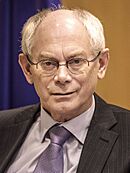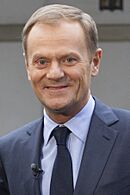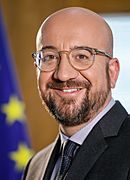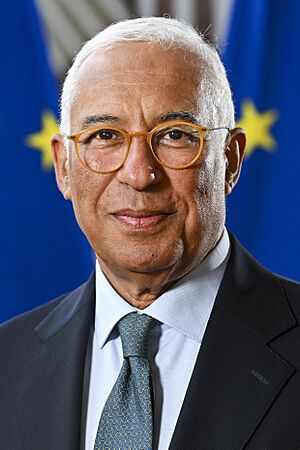President of the European Council facts for kids
Quick facts for kids President of the European Council |
|
|---|---|

|
|

Emblem of European Council
|
|
| European Council | |
| Style | President |
| Member of | European Council (non-voting) |
| Residence | Europa building |
| Seat | Brussels, Belgium |
| Appointer | European Council
by qualified majority
|
| Term length | 2.5 years, renewable once |
| Constituting instrument | Treaties of the European Union |
| Precursor | Chairman of the European Council |
| Formation | 1 December 2009 |
| First holder | Herman Van Rompuy |
The President of the European Council is a very important leader in the European Union (EU). This person leads the European Council, which is a group of leaders from all the EU countries. They also help guide the EU's work on the world stage.
Before 2009, the job of leading the European Council changed every six months. It was held by the leader of the country that was in charge of the presidency of the Council of the European Union at that time. But since the Treaty of Lisbon in 2009, there is a full-time President. This President serves for two and a half years and can be chosen again once.
The first full-time President was Herman Van Rompuy from Belgium. He started his job on December 1, 2009. After him, Donald Tusk from Poland became President. Then, Charles Michel from Belgium took over. Since December 1, 2024, António Costa from Portugal has been the President.
Contents
How the President's Role Changed
From Rotating to Permanent
The first meetings of European country leaders happened in 1961. They became official in 1974 and were called the "European Council." For many years, the leader of the European Council changed every six months. It was always the leader of the country that was holding the EU presidency at that time.
In 2007, a new agreement called the Treaty of Lisbon was created. This treaty changed the European Council's leadership. It created a new, full-time President position. This meant the job would no longer rotate every six months. This change aimed to make the European Council's leadership more stable and effective.
People had different ideas about what this new President would do. Some thought the President would mostly just lead meetings. Others thought the President would become a very powerful "President of Europe." They would speak for the EU on the world stage. The choice of Herman Van Rompuy as the first President suggested a more quiet, consensus-building role.
There were good reasons for having a permanent President. With the old system, a new leader took over every few months. These leaders also had to run their own countries. This made it hard for them to focus on EU meetings. Also, when they represented the EU at big global meetings, they were also representing their own country. A full-time President avoids these problems.
Choosing the First Full-Time President
The Treaty of Lisbon did not say exactly how the President would be chosen. Many people were suggested for the job. One of the most talked-about candidates was Tony Blair, a former British Prime Minister. However, some countries did not want him because he was from a large country that was not part of the eurozone.
On November 19, 2009, the European Council chose Herman Van Rompuy to be the first full-time President. He was the Prime Minister of Belgium at the time. Leaders praised him as someone who could bring people together. Van Rompuy said he would listen to everyone's ideas. He wanted all countries to feel like they won in negotiations.
What the President Does
Before 2009
Before 2009, the leader of the European Council was called the "President-in-Office." This person was the head of state or government of the country holding the EU presidency. This job changed every six months.
The President-in-Office was seen as "first among equals" among the other European leaders. They represented the European Council to the outside world. They also reported to the European Parliament after meetings.
After 2009

Today, the President's job is mostly about politics. The President gets the European Council's work ready. They organize and lead its meetings. They try to find agreements among all the member countries. After each meeting, they report to the European Parliament.
The President also represents the EU on global issues. This is especially true for foreign policy and security. However, there are other important EU roles, like the President of the European Commission and the High Representative of the Union for Foreign Affairs and Security Policy. Sometimes, their jobs can overlap. This can make it unclear who has the most influence.
Some people worried that the President might not have enough staff or resources. They thought the President might become a "play ball" between EU leaders. However, the system has worked well. The President of the European Council is seen as a "strategist" for the EU. Other EU leaders handle different parts of the EU's work.
The President of the European Council has also become more involved in financial policy. This is an important area for the EU. The changes from the Treaty of Lisbon have made the President's role more important.
Perks of the Job
The President of the European Council gets a good salary. It is similar to the salary of the President of the European Commission. This means a monthly salary of about €31,200.
The President also gets a car with a driver. They have about 20 staff members to help them. They also receive money for housing. The idea of an official residence or a private jet was rejected. These were seen as too symbolic and might cause rivalry with other EU leaders.
The President's Team
The European Council does not have its own large administration. The staff who help the European Council and its President come from the General Secretariat of the Council of the European Union. However, the President does have a small team of close advisors. This team is called their "cabinet."
For example, Herman Van Rompuy chose Frans van Daele as his first chief of staff. Van Daele had been an ambassador to many important places. Later, Didier Seeuws took over this role. The team also included Richard Corbett, a former Member of the European Parliament.
How the President is Chosen
Election Process
The President of the European Council is chosen by the leaders of the EU countries. They vote using a special system called a "reinforced qualified majority." The President serves for two and a half years and can be chosen again once. The Treaty on European Union explains the President's duties.
Some people have wondered if the President should be chosen directly by citizens. This would give the President a stronger voice. It would also make the job more democratic. However, this might cause problems with the European Parliament or the President of the European Commission. It could make the EU's government more like a presidential system.
Working with the European Commission
There used to be some concerns about how the President of the European Council and the President of the European Commission would work together. The rules in the treaty were not very clear. Some people saw the European Council President as the "strategist" and the Commission President as the "head of government."
Even though they had weekly meetings, there was some competition between the two roles. The European Council President's job has become more powerful. But the Commission President still holds many important powers. Both presidents often attend international meetings together.
Some people have suggested combining the two jobs into one. This would create a single, powerful leader for the entire EU. However, some countries might not want such a high-profile position. If the jobs are not combined, there could be continued rivalry between them. The European Council President has prestige, but less direct power. The Commission President has power, but perhaps less prestige.
Leaders of the European Council
Permanent Presidents
| N. | Portrait | President (Born–Died) |
State | Took office | Left office | Party | European party | Refs | |
|---|---|---|---|---|---|---|---|---|---|
| 1 |  |
Herman Van Rompuy (born 1947) |
1 December 2009 |
30 November 2014 |
CD&V | European People's Party | |||
| 5 years | |||||||||
| 2 |  |
Donald Tusk (born 1957) |
1 December 2014 |
30 November 2019 |
PO | European People's Party | |||
| 5 years | |||||||||
| 3 |  |
Charles Michel (born 1975) |
1 December 2019 |
30 November 2024 |
MR | Alliance of Liberals and Democrats for Europe | |||
| 5 years | |||||||||
| 4 |  |
António Costa (born 1961) |
1 December 2024 |
Incumbent | PS | Party of European Socialists | |||
| 1 year, 32 days | |||||||||
Timeline of Presidents

See also
 In Spanish: Presidente del Consejo Europeo para niños
In Spanish: Presidente del Consejo Europeo para niños
- List of presidents of EU institutions
- President of the European Parliament
- President of the European Commission
- Presidency of the Council of the European Union
- President of the European Union


